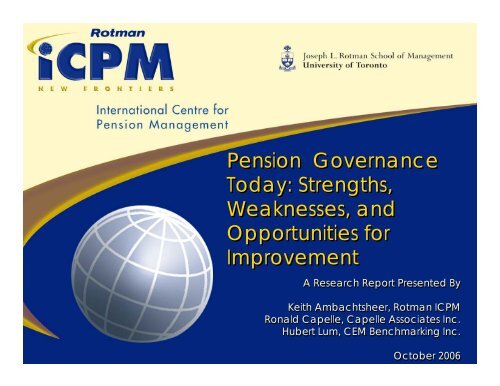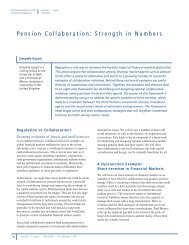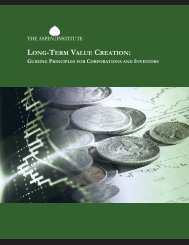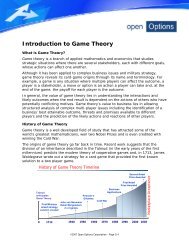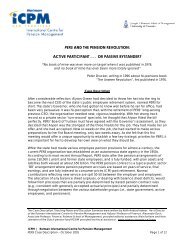Pension Governance Today: Strengths, Weaknesses, and ...
Pension Governance Today: Strengths, Weaknesses, and ...
Pension Governance Today: Strengths, Weaknesses, and ...
- No tags were found...
You also want an ePaper? Increase the reach of your titles
YUMPU automatically turns print PDFs into web optimized ePapers that Google loves.
<strong>Pension</strong> <strong>Governance</strong><strong>Today</strong>: <strong>Strengths</strong>,<strong>Weaknesses</strong>, <strong>and</strong>Opportunities forImprovementA Research Report Presented ByKeith Ambachtsheer, Rotman ICPMRonald Capelle, Capelle Associates Inc.Hubert Lum, CEM Benchmarking Inc.October 2006
Why This Study Now?• Spotlight has been on corporategovernance• Now turning toward pension fundgovernance• Little has been published to date onpension fund governance
Prior Published Studies• 1992: O’Barr <strong>and</strong> Conley• 1998: Ambachtsheer, Capelle, Scheibelhut• 2006: Clark, Caerlewy-Smith, Marshall
Research Design: Funds• Senior executives from 81 pension funds forwhich CEM Benchmarking Inc. hadperformance data• Aggregate assets of these pension fundswas $1.4 trillion dollars at end of 2004
Characteristics of the Responding<strong>Pension</strong> Funds at December 31, 2004RegionAustralia / New Zeal<strong>and</strong>CanadaEuropeUnited States% (EW) *4%41%11%44%% (DW) **1%13%32%54%Sponsor TypeCorporatePublic SectorOther% (EW) *38%41%21%% (DW) **14%66%20%SizeBillions of $USD* Equal-weighted ** Dollar-weightedMedian$3.7BMean$17.9 B
Research Design: Survey• Part I – 45 statements• Aspects of oversight, management <strong>and</strong> operations• Ranked on a 6 (most positive) to 1 (least positive) scale• Averaged to create a single ‘CEO’ score• Part II – 2 Open Ended Questions• Question#1 – key oversight challenges (63 responded)• Question#2 – key management challenges (60 responded)• Summarized by question• Results were compared to the 1997 surveycompleted by 80 fund executives (using thesame 45 statements)
<strong>Pension</strong> Fund Oversight <strong>and</strong>Management: What Really Matters?What are the more important oversight issues?Agency / context issues<strong>Governance</strong> effectiveness issuesInvestment beliefs / risk management issuesProportionof Responses44%36%20%What are the more important management issues?Strategic planning / management effectivenessAgency / context issuesInvestment beliefs / risk management issues73%15%12%
<strong>Pension</strong> Fund <strong>Governance</strong> <strong>and</strong>Management: Specific Challenges• Agency / context issues• Balancing stakeholder interests• Underst<strong>and</strong>ing the legal / regulatoryenvironment• Oversight effectiveness issues• Appropriate skill / knowledge set for the Board• Clear delegation to management
<strong>Pension</strong> Fund <strong>Governance</strong> <strong>and</strong>Management: Specific Challenges (cont’d)• Investment beliefs / risk management issues• Underst<strong>and</strong>ing context-based risk <strong>and</strong> its management• Informed ‘investment beliefs’ <strong>and</strong> their relevance• Shift to risk budget-based investment process• Strategic planning / management effectivenessissues• Resource planning, organization design, <strong>and</strong>compensation• Clear delegation from the Board• Effective IT-based implementation systems
CEO Score Highlights• CEO attention has shifted from operationalto management themes• Board competency, board delegation<strong>and</strong> compensation levels representpersistent problems• Positive association between performance<strong>and</strong> governance clustered around theyears in which CEO Score was measured• Quality of governance varied over time
Relative Frequency of CEO Scores 1997 versus2005. Everyone Above Average All the Time40.0%% Relative Frequency30.0%20.0%10.0%0.0%≤3.5 >3.5≤4.0 >4.0≤4.5 >4.5≤5.0 >5.0≤5.5 >5.5≤6.019 9 7 3.8% 7.5% 20.0% 27.5% 28.8% 12.5%2005 2.5% 9.9% 11.1% 28.4% 25.9% 22.2%CEO Score1997 CEO Scores 2005 CEO Scoresmean 4.8 4.9std deviation 0.6 0.7
Six Highest Scoring Statements in 1997<strong>and</strong> 2005 Show Shift in FocusRanking19972005Ranking1I can describe our mission.*I can describe our mission.*12Superior investment performancereduces future contributions.I ensure the setting of appropriate<strong>and</strong> underst<strong>and</strong>able performancest<strong>and</strong>ards for our investmentmanagers.*23Our board of governors does agood job representing theinterests of plan stakeholders.I can describe our values.*34I ensure the setting of appropriate<strong>and</strong> underst<strong>and</strong>able performancest<strong>and</strong>ards for our investmentmanagers.*I can describe our fund’s strategicpositioning.45Employee sub-par performance isunacceptable in our organization.There is a high level of trust betweenthe board of governors <strong>and</strong>management.56I ensure the setting of appropriate<strong>and</strong> underst<strong>and</strong>able values <strong>and</strong>ethics for employees.*Developing our investment policyrequired considerable effort <strong>and</strong>represents our best thinking.6
Six Lowest Scoring Statements in 1997 <strong>and</strong>2005 Show Persistent ProblemsRanking19972005Ranking40Compensation levels in ourorganization are competitive.Compensation levels in ourorganization are competitive.4041My board of governors does notspend time assessing individualinvestment managers orinvestments.My board of governors does notspend time assessing individualinvestment managers orinvestments.4142My board of governors examine <strong>and</strong>improve their effectiveness on aregular basis.My board of governors examine <strong>and</strong>improve their effectiveness on aregular basis.4243Our fund has an effective processfor selecting, developing, <strong>and</strong>terminating members of the boardof governors.I have the authority to retain <strong>and</strong>terminate investment managers.4344I have the authority to retain <strong>and</strong>terminate investment managers.Our fund has an effective processfor selecting, developing, <strong>and</strong>terminating members of the boardof governors.4445Performance-based compensation isan important component of ourorganization design.Performance-based compensation isan important component of ourorganization design.45
Six Statements with the Largest ScoreChangesRanking123456StatementI have clearly-written documents describing our mission,vision, values, strategic positioning, <strong>and</strong> operations <strong>and</strong>resource plans.My board of governors examine <strong>and</strong> improve their owneffectiveness on a regular basis.Superior investment performance reduces futurecontributions.I can describe our operational plan relating to what we aregoing to accomplish in terms of quality, quantity, timeliness,<strong>and</strong> resource requirements.Employee turnover is low.Compensation levels in our organization are competitive.ScoreChange+ 0.55+ 0.54-0.53+ 0.53+ 0.43+0.42
Positive Association Between <strong>Governance</strong> <strong>and</strong>Performance Near Years CEO Score MeasuredFour-Year NVA Performance vs 1997<strong>Pension</strong> CEO Scores Co-efficientsFour-Year NVA Performance vs 2005<strong>Pension</strong> CEO Scores Co-efficientsNVA-CEO Co-efficient+0.8+0.6+0.4+0.2+0.0-0.21997CEOScoresNVA-CEO Co-efficient+0.8+0.6+0.4+0.2+0.0-0.22005CEOScores-0.41997 CEO Score vsNVA Co-efficient95 96 97 98 99 00 01 02 03 04 050.3 0.2 0.4 0.3 0.4 0.1 -0.1 0.1 0.1 0.3T-Values 1.3 0.8 2.0 1.3 1.4 0.4 -0.4 0.2 0.2 1.0Last Year of 4-Year PeriodNANA-0.42005 CEO Score vsNVA Co-efficient95 96 97 98 99 00 01 02 03 04 05-0.5 -0.3 -0.1 0.0 -0.2 0.3 0.4 0.6 0.8 0.4 NAT-Values -1.4 -1.2 -0.7 0.0 -0.4 0.9 1.5 2.8 2.7 1.9Last Year of 4-Year PeriodNA
Quality of <strong>Governance</strong> Varied overTime• 35% of funds responded to both the 1997<strong>and</strong> 2005 governance survey• Mean <strong>and</strong> variance of CEO Scores forrepeat participants was similar to thelarger group in 1997 <strong>and</strong> 2005• Correlation of 1997 <strong>and</strong> 2005 CEO Scoresfor the repeat participants was low at 49%
Oversight / Management Costs vs.CEO Scores• Statistically significant positive relationship• At the $10B fund level, high-scoring fundsspent an average $4M per annum moreon oversight / management costs thanlow-scoring funds.
<strong>Pension</strong> Fund <strong>Governance</strong>: <strong>Strengths</strong>• High levels of dedication <strong>and</strong> trust• Strategic planning being formalized• Increased emphasis on resource planning,organization design, <strong>and</strong> compensationpolicies
<strong>Pension</strong> Fund <strong>Governance</strong>:<strong>Weaknesses</strong>• Board member selection processes• Board effectiveness evaluation processes• Board micro-management• Undue compensation constraints
Opportunities for Improvement• Remove ‘competing financial interests’problem• Construct ideal board compositiontemplates• Initiate board self-evaluation processes• Clarify board-executive roles• Address HR competitiveness issue
Future Research Activities• Legislative / regulatory roles in improvingpension fund governance?• St<strong>and</strong>ardized risk-adjustment of returns?• Linkages between corporate governance<strong>and</strong> pension fund governance?• Case studies?


